Duets: student and artist-mentor exchanges
One of the two main components of a student’s course of study in the MFA-VA program at Vermont College of Fine Arts is a semester-long studio project in which the student develops and/or challenges specific aspects of their art practice under the guidance of an Artist-Mentor.
The VCFA Artist-Mentor network is comprised of prominent contemporary artists who mentor students individually, during the semester. With over 1500 Artist-Mentors across the United States and Canada, VCFA students are ensured mentorship with a different Artist-Mentor each semester.
Student: Josephine Chase (S 22)
Artist-Mentor: Zun Lee
VC Project Title – How To See A Work of Art in Total Color: Race, Representation & Reclamation
Studio Title – Driven Into Nature: Transforming Topographies
This semester I’m working on overhauling a ’74 MG into a new installation. I’m painting and detailing every inch of it! I’ve also been working with other automotive signifiers like maps and traffic signs using sourced materials from hardware stores like paint chip samples and wallpaper.
Zun Lee, Josephine Chase’s 2nd Semester Artist-Mentor, is a visual artist, physician and educator. Born and raised in Germany, he currently lives and works in Canada and the US. Through lens-based storytelling, archival and socially engaged practice, Lee investigates Black everyday life and family spaces as sites of intimacy, belonging and insurgent sociality against cultural displacement and erasure. Lee has exhibited and spoken at numerous institutions in North America and Europe. His works are widely published and represented in public and private collections around the world. More of Lee’s work can be seen on his website and on his Instagram. Selected honors and awards include: Outwin Boochever Portrait Competition Finalist (2019), Andrew W. Mellon Foundation Practitioner-in-Residence (2019), Knight Foundation Grantee (2018), Art Gallery of Ontario Artist-in-Residence (2017), Magnum Foundation Fellow (2015), PDN Photo Annual Winner (2015), Paris Photo/Aperture Photobook Awards Shortlist (2014), PDN 30 (2014)
Is there a structure to your exchanges?
J: Yes, but there is a lot of built-in expectation that things change. The process of working as an artist is often organic, you find inquiries or adventures along the way in the studio that you get really excited about. One of the great things that comes out of working with Zun is that I find our meetings are also a great check-in point where I have all of these light bulb moments. Knowing that we will be having our conversation gives me time to meditate and vocalize things going on in the studio and to realize – “I see what I am doing there and now this conversation is making me think about this other venture”. I really enjoy that room to grow.
Z: I can echo what Josephine said. Specific to still ongoing pandemic constraints and the way that Josephine decided to continue expressing her work by blurring the lines of the institutional and the domestic, it was important for me to make space for the fact that there’s no dedicated time within which inspiration strikes. A lot of the current work that Josephine engages in hinges on moments that become these light bulb moments occurring out of everyday life. They may not necessarily be moments of production or conceptualization. It’s just for Josephine to get a better sense of how she functions in her space whether it is the studio or the home and what that means in how the work articulates itself. In that sense there is a structure, but it’s not bound by space and time. It’s more about those moments of inspiration that we try to build structure around.
Josephine has been really good about sending texts with images of something that spontaneously unfolds or when she has an idea. I look forward to seeing those. Our practices are very similar in that we both focus on Blackness and domesticity and the domestic space as an expression for a kind of interiority, and how that interiority manifests in terms of how Blackness performs and signifies. It’s always interesting for me to see what her take on these things is.
Josephine, how have the conversations with Zun affected your process and thinking regarding your work?
J: I feel more freedom this semester in terms of really wanting to go for it and really push some of the ideas and projects that I have been interested in for a while now. It’s also my second semester in the program and I think my first semester was figuring out the mode of working in a grad program. I was thinking about what kind of work I should be making but this semester I don’t really feel that way. I have done some landscaping so far and I’m tackling a larger scale piece that I have wanted to do for years.
In my conversations with Zun I feel really supported and I just want to go for it. I also feel our conversations are really generative and I am appreciative of that; I come away with more ideas. I don’t know if it’s just me, but as an artist you can get so stuck on how you are working and Zun always does a great job of brainstorming big picture ideas and asking questions. How does this function in a longer format? Where is this going to create a new path of departure for future work? And that’s a really cool way to be thinking – in terms of the micro and the macro.
Can you give a specific of when that happened – where you were directed to think about something in the micro and the macro?
J: All of these arenas of making – landscaping, transplanting trees or food work, I call the sides of my practice. Zun does a really great job of pushing those elements of making – the daily sorts of material investigations that really excite me. He puts as much emphasis on those peripheral activities as some of my main focuses, like the maps from this semester.
I am also thinking about working with hardware and the idea of having a matrix or format built in where I am able to switch out all of these different materials to still work with each other and how that idea of an index of materials is also another point of departure that I can always be referring to and using. It is a way of thinking that becomes a tool for me to use.
Z: That was interesting for me because I am primarily a lens-based artist, even though I focus on the domestic and what the domestic can be in terms of representation, identity, and self-expression. To play devil’s advocate – the fact Josephine does a lot of work in landscaping and home improvement and things that are dismissed as crafts like paper making, textile work, quilt making, gave me permission to look at what she does, and ask, without necessarily giving her direction, what would I do if it was my practice to work with textiles, or plants, or discarded objects from around my house?
What are the questions that I would ask of myself and the considerations I would place around my work if I had to think about how would this work in an institutional context and how would this work in a very specific domestic context where I think specifically about use value more than the aesthetics? Looking at her work as it unfolds gives me permission to think about those things for myself. In that sense it has been very much a mutual thing.
How do you think about those questions of use value and context as they relate to your process?
J: I have always had this question about how the institution functions to support my work and ways that I am fighting against it in my modes of working. It is especially interesting now because I’m not a digital artist. A lot of my work is based on being able to experience it in person. I get a lot out of being able to see people in a space next to my work. That’s always been a reward I built into the amount of time and labor I spend with things. I like the idea of people being able to spend time with the work in its space and discover all of the detail which is just really hard to capture sometimes.
In this pandemic space I have been really thinking about being in an art school and how you have this idea of having an installation space, that privilege of having a space that’s dedicated towards your re-imagination. And now not having that has instead presented formal parameters that have made me look at my domestic space, which I have always been pulling from to bring into the institution any way. I am now cutting out the middleman in essence and thinking about what does that look like when I am turning my home into a site for experiencing art?
And that is a really interesting conversation. What is it like to invite somebody over to your home vs what is it like when somebody is moving through a museum? What are the patterns of behavior that we observe? That has been really exciting too, it allows me to spend time thinking about the viewership of my work. I am always thinking about that hospitality aspect. What is this doing for someone when they look at it? That’s one way in which those questions about the institution vs domestic space manifest in my thinking.
Can you describe a pivotal exchange or moment that helped shift something for you?
J: Pretty much after every meeting it’s been like a checkpoint and a time to push things further. Our first meeting, coming out of the last residency, I was thinking about a lot of two dimensional work: map making and working with readymades. After our second meeting – [Josephine’s dog Pluto can be heard barking in background]
Z: What’s happening now is very much the way we worked: daily life inserting itself, not so much interrupting, but inserting itself as a reminder that these conversations have a context of what’s actually happening. The dog is very much part of it.
J: After our second meeting, I had been working on excavating this 1974 decrepit MG from my back yard. I was talking about the history of this vehicle and how I really had it in my mind that I wanted to work on this car for two or three years now and I just remember it being a really great conversation in the sense that Zun just got it. He was asking questions that were directly tied to some of the studio questions I had: how do I reanimate these family stories? What does it do to something to reimagine its function?
We just had a meeting, our first after receiving news that this next residency will be online. It was a really interesting conversation because that’s when I started to say – ok this is how I am going to display the work. I’m going to use the sites that I have already been working from, my home, as installation sites for art. Then we started talking again about those ideas of how the museum functions against this backdrop of home. That was a pretty recent breakthrough conversation.
Z: I never know what questions to ask or how to structure the conversation. I draw the inspiration from just how Josephine throws things at me. Including the example of the old car chassis in the back yard and her intention to repurpose it for some kind of studio work. I have a penchant for the discarded and the throwaway so that kind of intrigued me but also it was the way in which she spoke about this discovery that this could be something used as part of her work.
And you mentioned this groundhog – the car had been covered by vegetation and underbrush and in order to use the car or repurpose it she would have to clear out all this vegetation that had grown over the car and then she realized that this groundhog had used this car to hibernate in and she said she had to wait until winter was over because she couldn’t just displace this groundhog from this car. Again, this whole idea around displacement and migration.
The way she cared about not doing it to the groundhog triggered this whole conversation around: what does it mean not to show the finished product or the end result of the repurposing or reclamation of something that was discarded but to show all the care and considerations that go into this process even before you’ve begun the process? Can caring about the groundhog having a home to hibernate in before you even touch this car somehow be part of the process? Can you work all these care considerations into the work itself?
So that became central to the investigation as well. What does it mean to hear stories about the groundhog and all these things? We are not sure yet where this will go in terms of how you can show this, now that again, the pandemic has imposed some constraints around what can be shown and how. Again, for us these are not so much challenges as considerations for thinking more deeply about materiality and how to deal with the haptic in this work. Especially if we can now only visualize it – is there still a way to imbue the haptic quality of this work?
What is the relationship of the car to you and has it always been on the property?
J: It was my paternal aunt’s first car. She was a painter. The car sat outside, dug into the ground of another family property for decades. When that family member passed the car made its way over here and the same thing happened, nobody was using it, nobody was fixing it. It just became overgrown in this other location. And it still would have been.
I am trying to find a use value for it and a way to honor these stories of whoever had it. It sat next to another aunt’s car, my maternal aunt’s, who abandoned her car when she got deported. So they sat next to each other – sister cars. The MG I am working on is embedded much deeper into the soil than the other car. I worked with it a bit, pulling parts off, painting them and thinking about that deportation, the migration, and the idea of an abandoned car that clearly doesn’t function any more as this really visual signifier of a person having left. Thinking about how it used to move and take somebody somewhere but now it can’t move, and it’s clear that nobody has been in it for a long time. It has all of that residue of human experience.
Like for Zun, that type of degradation of an object is very poetic to me too. I see something in there and I definitely get fascinated by it. That’s what that car meant to me – existing there as this problem that no one wanted to look at and me actually looking at it and thinking – wouldn’t that make a really great painting?
How have you been challenged by your exchanges with Zun?
J: One of the biggest challenges is having me get what I need out of this MFA Program and the idea that getting your MFA does not make you an artist. I came here as an artist so having this experience really work for me is where I feel I get pushed the most by Zun. Not just to think about what I should be making for this program or what I should be making semester by semester. What I value about our mentorship is that he sees me as an emerging artist and my career with the big picture in mind.
He is in that space of supporting these projects but also asking – “What is this doing? How does this help you grow as an artist?” The idea that nothing is just for school. That all of this is going to stack up to become these other possibilities for me to work with. I may be making it all sound rosy but that is a challenge too. It’s a good thing to be pushed in that way too, having my experience mirrored back to me, to get what I want out of it. That’s a really helpful mode of thinking.
What will you take into the next semester from your work with Zun?
J: I think there is so much. I’m trying to think of quantifiable things. I think overall there is a freedom to how I am working this semester that is important. It feels like the work I am doing now in terms of scale and the amount of work is really big, and I am certain that this not just a put a button in it in July kind of thing. Working on these cars is going to take me right in to next year when I will be graduating.
I want to make sure that each semester I am working on things that make sense to me – things that make sense to what my vantage point is in a really exciting, overwhelming landscape of artists making really cool work. Asking myself – what do I like to make – and being connected to that part of self and really feeling a lot of support that these stories I like to work with and animate are important. Never to lose during this time that they have something to add to the conversation.
And hopefully too, that’s the great thing about the program, is getting to stay in touch with your artist-mentors and have this resource of people who understand how you are working that you can check back in with to say – this is what I am working on and up to. I’m really excited to have those conversations too.
Z: What you just said is something that often gets lost. What do I like to do? What do I get joy out of making? There is always so much pressure to deliver in an MFA program where everybody works towards a final show and everyone thinks in terms of milestones. What gets lost is the initial wonderment that made you an artist in the first place. The question of what do I like to make and not what gives me an A or what this professor likes to see or that professor likes to hear. Being mindful that you are allowed to actually think about what brings you joy and make things that you enjoy making. That’s the place from which it all starts, and all comes back to. You will succeed in a program no matter the intensity if you focus on what you like to make.
And this isn’t a trivial question, not even in terms of how Josephine and I interact, because a lot of these conversations, even though they seem free form and very spontaneous and driven by the moment, are actually very rigorous and all undergirded by critical theories. Very specific theories that we always keep coming back to and we are mindful that yes, this is still an MFA program, and we are having to hang our free form conversations against certain frameworks. We are always mindful that these frameworks exist, and we also don’t forget that these frameworks are not corsets, they are not constraints. They are supposed to help us ask deeper and deeper questions. A lot of people think of the framework first and ask how does my work fit into the framework? I think it should be the other way around. I’m the artist that I am and what frameworks are there that support what I am doing?
We are always mindful that there are specific thinkers in this space that we both resonated with, and that as much as we have these free form conversations, there is always something that undergirds that. It’s important to focus on what made you a maker in the first place and to see yourself as part of a lineage of critical thought and creative inspiration. That’s always been in the back of our minds. As much as we like to be spontaneous, there is some framing of that spontaneity that goes on as well. There are specific people that we constantly quote.
J: One thing that we really connected on was “In Our Glory” by bell hooks from Visual Politics. It was so exciting to think about how, in that particular text, black photography within the home functions as a site of resistance against white supremacy from the outside. To read how this domestic space was being considered as this very important artscape was really connecting and to think about pictures of ancestors within my home serving as these art objects or these places of worship. For example, there is a photo of my maternal grandfather, Yarkpazua Komeyan, that my mom speaks to if we are nervous about something. When I wanted to get into grad school I asked my mother – can you talk to grandfather and make it happen?
hooks’ method of working and writing that blends personal narrative with critical theory was so impactful for me to discover because I am working with personal narratives and tribal narratives. I’m also pulling from a legacy that doesn’t have a written language, where all the information is disseminated to you orally. It is so important finding writers that are able to blend that and use these examples that aren’t exploiting a family and also showing how these examples operate in and amongst a network that serves to support or dismantle Black domestic life. To have Zun’s connection with that reading acknowledged that now we can talk about this stuff that I really do want to talk about.
That’s one example. I have been reading a lot of Darby English this semester too. Thinking a lot about how to avoid performing Black art back to institutions, but also how to find ways to talk about art expansively and operate in a mode of joy, as Zun mentioned, and magnificence and celebration. What if I want to use bright colors or if I want to be joyful and want to tell these legacies and do it in a way that represents my family and our history in a manner that feels uplifting? It can be so horribly re-traumatizing to go into museums sometimes and see how your people are reflected. Zun and I love to talk about this stuff – it is a soul tie and a connection to have a space where you can a have a conversation, not just about what you want your art to look like, but also how these spaces can counter or support that.
Z: There is always this question with Josephine’s work of: is what I am making enough? Is it strong enough or forceful enough? Maybe these are not attributes we need to speak to. And yet, at the same time, not evading the question, just relying on the fact that the work we make has a very specific context and doesn’t need to explain itself. It can very much remain opaque and the power of this kind of articulation of Blackness can remain in the opaque to function.
What that means in this specific context is hopefully something that Josephine can take away even beyond the semester of this program. To not have to rely on the institutional context of what her work needs to be, or to express, but just rely on the fact that she is enough. Her work is enough, and it can rely on this enoughness of what she is trying to express to function in the way of Blackness.
What do you want to see in the world? At the end, you have to live in it and you have to make it work for you, your family, and your context. This idea of beautifying a space and making it suitable for you is very much a part of that.
J: I think of art making as a restorative space and my practice itself as a refuge. Art and the act of making I find really generative, healing, and restorative. How antithetical would it be to my practice if I worked with subject matter or made things that disconnected me from wanting to get up and make stuff every day? That needs to be respected as a sacred space. Being able to play around with color, materials, and texture is healing for me too. I am letting the studio still be this place where I can get some solace, but with the idea that everything I’m making is still operating within these constructs, these contexts I speak to.
What advice would you give a new student thinking about selecting an Artist-Mentor?
J: One of the interesting things about working in this hybrid method you get the option to work with someone who is non geographically close to you. Getting a critique with Zun, who was a visiting artist for our last residency, and speaking to him about my work felt different for me than other professional artists. I really wanted to work with him and asked the program if that was an option because Zun is in Canada. Luckily this program, and the method we have been working in now, was able to accommodate that. Some advice I would give a new student is: you have contacts that VCFA gives you about artist-mentors who are near you, but approach the residency as a chance to listen during the artist talks and ask questions.
I am so grateful to have worked with Zun this semester and it would have been such a disservice to myself to not even ask if that was a possibility. Just ask, and really pay attention to when you are connecting to the way somebody speaks about their professional practice and also pay attention to their style while they are talking to you during critiques. Sign up for a bunch of crits. Some go great, some are not so great too. I had a not so great crit the night before going into Zun’s crit and he received me in that moment where I was feeling a bit more insecure about my work, and that was a really cool feeling too. Put yourself out there.
Also, there is no type of artmaking you can’t learn from. I worked with Leslie Fry for my first semester who is a sculptor and Zun deals with photography and I self-describe as an expanded field painter.
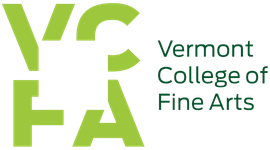
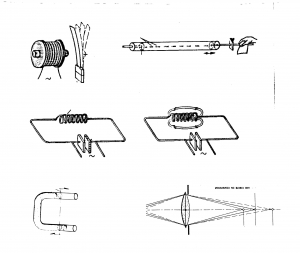
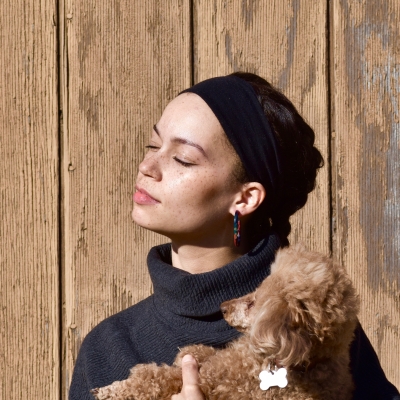
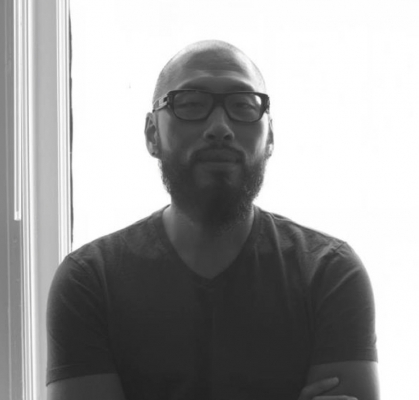
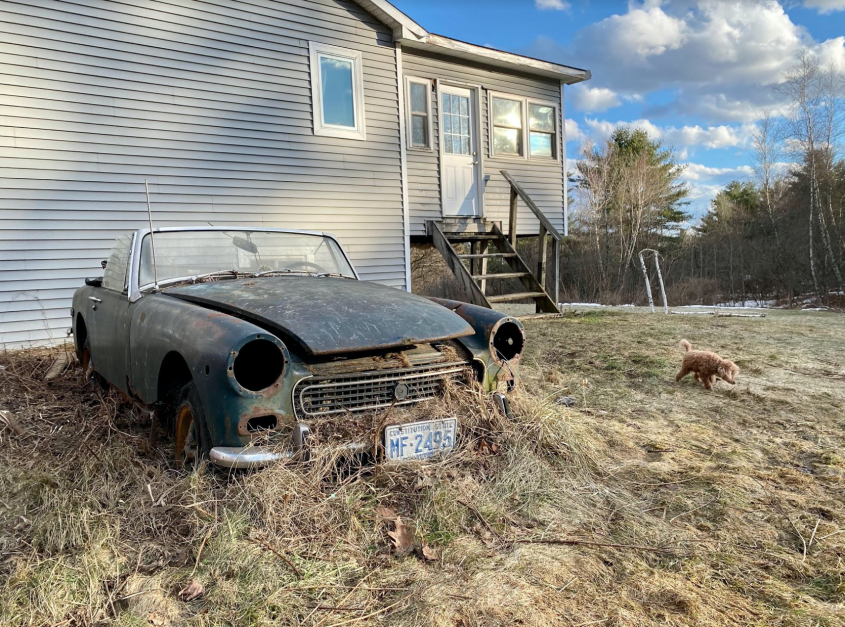
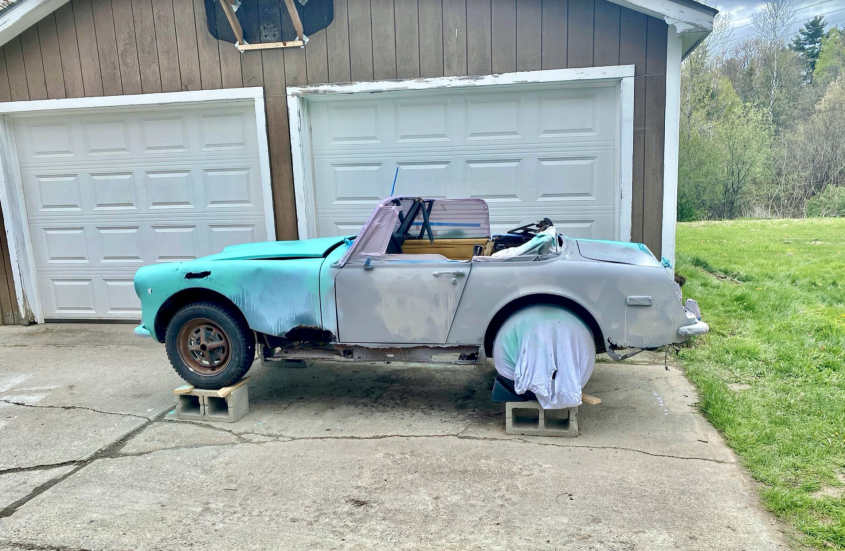
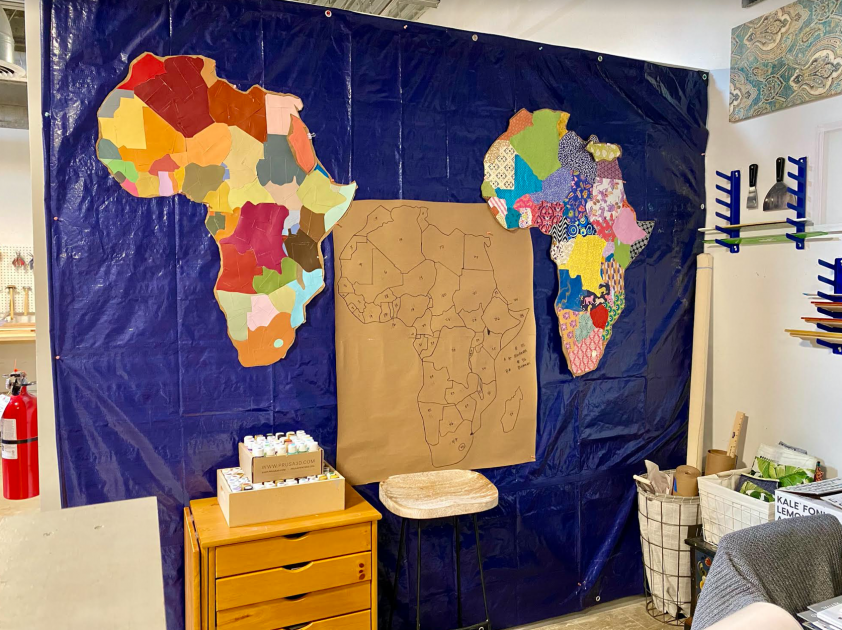
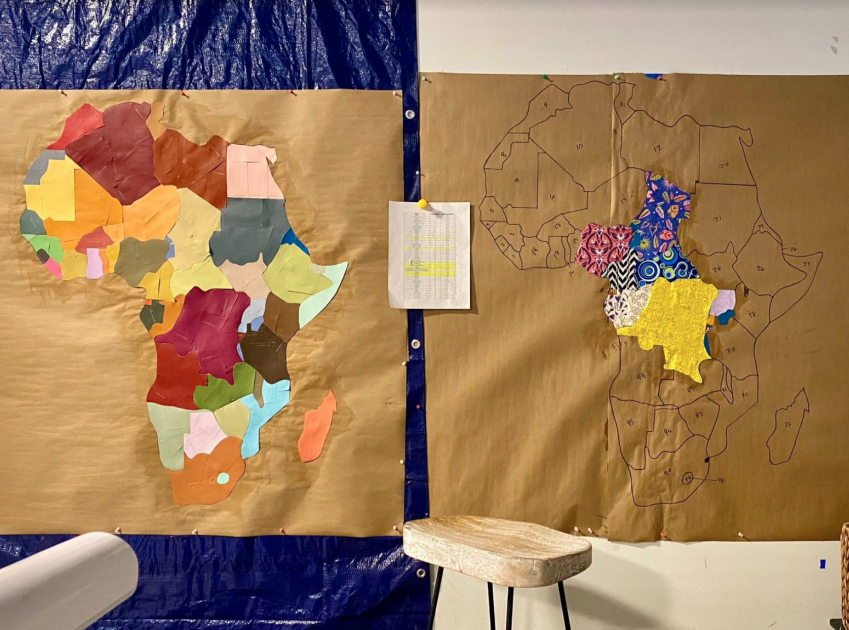
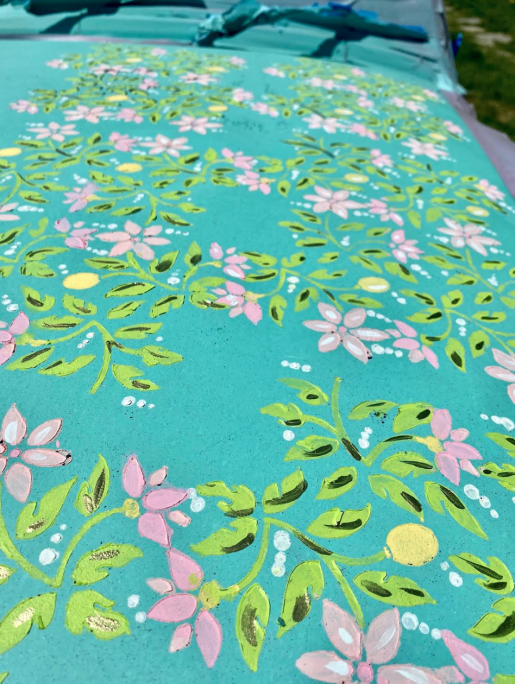
 Alumnx: Jo Ann Block (S 11)
Alumnx: Jo Ann Block (S 11) Student Matthew Gernt (S 21) and Artist-Mentor Parastoo Anoushahpour
Student Matthew Gernt (S 21) and Artist-Mentor Parastoo Anoushahpour